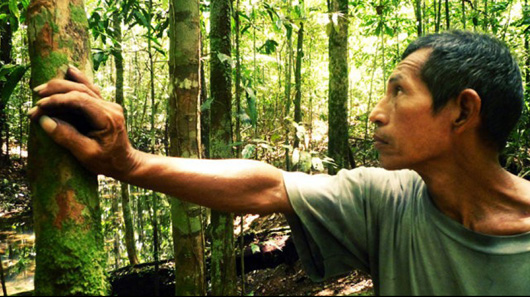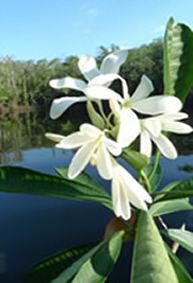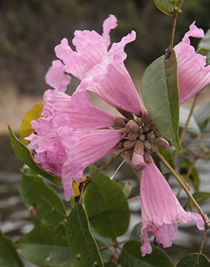Brazil: Community botany in the heart of the Amazon
13.10.10
Annie Cooper (volunteer) and William Milliken (Royal Botanic Gardens, Kew) talk about how a community organisation is changing lives - and taking up botany - deep in the Amazon.
By 1990 the inhabitants of ten tiny communities scattered along the Jauaperi river in northern Brazil realised their traditional ribeirinho (riverbank) livelihoods were under threat. Despite the richness of their environment, the communities faced tough social problems. Their land covers a range of Amazonian habitats, from ‘terra firme’ (dry land) rainforest to seasonally flooded ‘igapó’ and ‘campina’, each supporting its own diverse range of plant and animal species, and providing many of the essentials for their livelihoods.

Guido Pereia (Paulinho) in the 'terra firme' forest at Xixuaú, which supports as many as 200 species of trees per hectare, as well as many other species of lianas, shrubs and herbs
© Tomica Bajsic
Without decent health care, education or opportunities for work, the young people were
deserting the villages, all too often ending up in the slums of Manaus (30 hours away by boat). In exchange, illegal hunters, commercial trawler boats, and social problems like alcohol abuse were drawn in from outside. The ribeirinhos had to make some changes so they got together and decided to set up the Amazon Association, based in the community of Xixuaú. The Association's first action was to pool their land, safeguarding 178,000ha of rainforest as the Xixuaú-Xiparinã community reserve.

The journey up the Rio Negro: in the high water season it floods the surrounding 'igapó' forest to a breadth of 30km, with waters dark with humic acid from incomplete breakdown of vegetation in the surrounding forests © Tomica Bajsic
Xixuaú–Xiparinã and the campaign for an extractive reserve
The Xixuaú-Xiparinã community reserve lies in the heart of the Brazilian Amazon, on one of the northern tributaries of the Rio Negro. Biologists are still getting to grips with the diversity of the Amazon flora and many parts of the basin have yet to be studied, but it is known that Central Amazonia hosts one of the highest levels of plant diversity in the region. From the research perspective this area is virgin territory, and scientists are confident that detailed studies of the pristine environment at Xixuaú-Xiparinã will produce important new discoveries.
The people of the Jauaperi developed the Amazon Association with support from a Scot, Chris Clark, who helped develop long-term partnerships with conservationists in Italy.
 Together their remarkable achievements have included a new school, a 95% reduction in malaria, clean water and solar energy. The Amazon Association is working to increase the reserve threefold, incorporating all the Rio Jauaperi communities as the Lower Rio Branco-Jauaperi Extractivist Reserve, or Resex, now awaiting the final stage of ratification. The campaign for the approval of the Resex is supported by local and national NGOs including the Rio Negro Network (founded by WWF-Brazil, Fundação Vitória Amazônica and Instituto Socio-Ambiental).
Together their remarkable achievements have included a new school, a 95% reduction in malaria, clean water and solar energy. The Amazon Association is working to increase the reserve threefold, incorporating all the Rio Jauaperi communities as the Lower Rio Branco-Jauaperi Extractivist Reserve, or Resex, now awaiting the final stage of ratification. The campaign for the approval of the Resex is supported by local and national NGOs including the Rio Negro Network (founded by WWF-Brazil, Fundação Vitória Amazônica and Instituto Socio-Ambiental).
The ‘molongo’ tree (Himatanthus sp.) yields a milky latex widely used for medicinal purposes in the Amazon © William Milliken

Some of the Xixuaú children play with eco-tourists' binoculars © Tomica Bajsic
The community botany partnership
The Amazon Association now needs new skills and partnerships to protect the greater area of the Resex, and ensure that every community can benefit sustainably. They have decided to set up a new community botany partnership with the Brazilian National Amazon Research Institute (INPA) and the Royal Botanic Gardens, Kew. This will not only research the flora of this remote area, it will give the ribeirinho communities the skills they need to make real improvements to their quality of life while safeguarding the rainforest across the expanded reserve.

Isaque dos Santos Marinho repairing thatch for the houses with 'ubim' palm (Geonoma baculifera), a technique common across indigenous communities in the Rio Negro basin
© Annie Cooper
 The aim of the community botany partnership is to promote sustainable livelihoods and long-term conservation of forest biodiversity and ecosystem services on the lower Rio Jauaperi. Specifically, it aims to develop the knowledge, information resources and skills necessary for the local communities to manage their resources in a sustainable manner, to engage in biodiversity research within their own land, and to identify and develop opportunities for generating realistic levels of income from their natural resources.
The aim of the community botany partnership is to promote sustainable livelihoods and long-term conservation of forest biodiversity and ecosystem services on the lower Rio Jauaperi. Specifically, it aims to develop the knowledge, information resources and skills necessary for the local communities to manage their resources in a sustainable manner, to engage in biodiversity research within their own land, and to identify and develop opportunities for generating realistic levels of income from their natural resources.
'Pau d'arco' (Tabebuia sp.), a relative of the national tree of Brazil (Tabebuia chrysotricha). The wood is traditionally used by indigenous communities for their hunting bows
© William Milliken
page 2 >